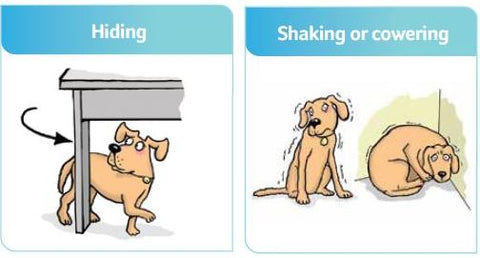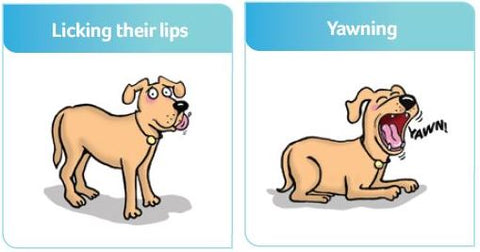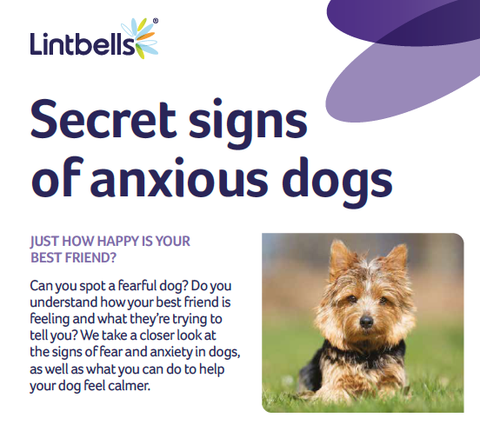
Signs of an anxious dog
What are the causes and signs of an anxious dog?
Did you know that anxiety in dogs is very common? Whether it’s postmen or kites, hot air balloons or other dogs, most of our pooches can find life stressful from time to time – it’s not just fireworks season! So do you think you can spot the signs of an anxious dog – and do you know what to do to help?
What is fear and anxiety in dogs?
All animals – from rhinos to mice, humans to dogs – feel fear. It’s what’s called a primal instinct, and flares in reaction to real and perceived fears. When the animal spots or hears a ‘danger’, the brain signals fear, and the fight, flight or freeze response is triggered. However, the important bit here is perception. The fear response that’s saved our (human and doggie!) ancestor’s skins time and time again can also be triggered in situations that aren't actually dangerous at all – our dogs just perceive danger.
Common kinds of anxiety in dogs
Broadly speaking, there are 4 different kinds of fear and anxiety in dogs:
- Instinctive fear response – another dog lunges, barks and growls at your dog. They instinctively find the situation it scary.
- Learned fear response – a child on a scooter accidentally crashes into your dog in the park. Your dog is hurt in the collision. They learn that children, scooters and the park might be dangerous, and become fearful and anxious: a) in the park; b) around scooters; c) around children; or d) any mix of a, b and c.
- Phobias – this is where your dog develops a long-lasting, extreme fear of something very specific. This can be of something seemingly random – fireworks, balloons, men with hats – or a learned fear response that has escalated after repeated exposurerepeatedly exposed to something they find scary (other dogs, strangers, travel… even children on scooters in parks!)
- Anxiety in older dogs – as our best friends near retirement, they can become more timid and anxious. Some older dogs also develop a kind of doggie Alzheimer's disease known as Canine Cognitive Dysfunction (CCD) – if your elderly dog becomes anxious or fearful or forgetful and confused, always pop to the vet.
So it’s not just firework season…?
Lots of us equate firework season with stressed pooches – but for some dogs fearfulness and anxiety is a 24/7/365 problem. That’s why it’s important to be able to identify the signs and situations dogs can find stressful...
What are the signs of an anxious dog?
The obvious signs of anxiety in dogs
There are some really obvious signs of anxiety in dogs which most of us will know already. That’s things like tucking their tail under their belly; shaking, crying, whining and trembling; and avoiding the scary thing by backing away, turning away, hiding or running. Some fearful or anxious dogs will become more clingy and cuddly, while others will seem restless and will find it hard to settle.

Subtle signs that your dog is anxious
You might see your dog doing something that seems out of context if they’re worried or scared… perhaps they’re yawning, sniffing the ground, licking their lips or 'shaking-off' – having a shake like they do when wet? If this seems to happen after coming into contact with something (or someone) regularly, it could be a sign of anxiety. These odd activities are known as 'displacement behaviours' and are your dog's way of finding a coping mechanism when they are uncertain about what to do.

The surprising signs of dog anxiety
Think you’ve got a ‘naughty dog’? They’re more likely to be a very upset, fearful. misunderstood dog. Some behaviours common in anxious dogs are traditionally viewed as ‘bad behaviour’. So if your dog is barking a lot, being destructive, having accidents in the house, growling or biting, don’t punish them – it’s likely they’re very fearful or anxious. Instead, seek help. These are the more serious signs of fear and anxiety, and call for a behavioural expert’s support ASAP.

so now you know what to watch out for, when might you need to be vigilant? let’s take a closer look at the common triggers of anxiety in dogs:
Stranger danger
Some dogs find other dogs – at home, or out and about – stressful. This can be down to a lack of socialisation when they were a puppy or as a result of bad experiences. Another common trigger is strange people. That can vary from the postman and people passing by or visiting your home, through to old friends who look or behave differently, or have a distinctive feature – that’s things like hats, beards, high viz jackets and
Separation anxiety
The bond between dogs and their favourite people can be very strong, and many dogs show signs of anxiousness when home alone. Behaviourists fear that more dogs than we might guess suffer in silence too – unless we rig up a webcam, it’s hard to know what happens when Fido is home alone. Many dogs become fearful or anxious if a trip to the kennels is on the cards too.
Transport, movement and vehicles
When you stop to think about it, it’s not surprising that our dogs can find travelling a bit scary – jumping in a metal box to move really quickly is a bit strange! Fears and anxiety often start with motion sickness or not enough socialisation and habituation as a pup, but can follow bad experiences too. As well as cars and public transport, other common motion-related fears include humans moving in unusual ways – people running, cycling or skateboarding.
Newness
Though many dogs are naturally outgoing and curious, some find things that are new and different scary. In practice, that might mean the terrifying bunting that’s invaded the street, an evil new sign outside a shop, or even holidays where they encountering situations or places they haven’t experienced before.
Children and new family members
Unfortunately, our best friends don’t always welcome new arrivals – that might be a new baby joining the family, or new pets! Unfamiliar older children can be scary too, as they are less predictable than adults, tend to move more quickly and make more noise.
Lots of dogs aren’t keen on loud noises. This covers the classic firework fears many of our dogs experience, through to the hated vacuum, sirens, bird scarers, even loud music!
Vets and grooming
As we mentioned, dogs can learn to find things scary, so even if you’ve socialised your pup very carefully, a ‘nasty’ trip to the vet or groomer can change their perception. It is possible to work on rebuilding more positive associations though.
How can you help your anxious dog?
Doggie fears – like our dogs – are individual, so there’s no one-size-fits all fix. But thankfully, there are ways to work with your dog to overcome their fears and anxieties. Techniques called desensitisation and counter-conditioning can be used as part of a therapy plan if something has already become scary – but it’s important to talk to the experts before beginning this kind of work.
Do I need to talk to my vet?
Once you’ve recognised that there is something worrying your dog, it’s a good idea to visit your vet and check that everything’s OK medically. If whatever is bothering your best friend isn’t medical, the next step is finding an expert who can set out a practical plan to help you and your dog work together to manage and improve the situation together.
Finding the right behaviourist
When it comes to working with fearful or anxious dogs, we always recommend finding a fully certified behaviourist. Always check to see they’re on the register of ASAB Certified Clinical Animal Behaviourists (CCABs) – this guarantees that your expert really is an expert, and is up-to-date with the latest information and techniques.
Out-of-date advice can actually do a lot more harm than good to your dog’s behaviour and welfare. That's why it’s really important to be careful and do your homework when you’re seeking behavioural advice.
Can supplements help stressed, fearful and anxious dogs?
Yes – in conjunction with expert advice. YuCALM Dog can make a tail-wagging difference by supporting natural calming pathways in the brain. It’s a great way to speed up and support your behavior modification work, as the scientifically proven ingredients reduce stress and support dogs to become more happy and playful. What's more, it's all natural, so you can use it long-term as you work with your behaviourist to help your dog learn to feel more confident and manage their fears in the long term.
Does your dog feel anxious? How do you help them cope with scary situations? Can you share a success story to inspire other pet parents who’re working with anxious or fearful dogs? We love to hear what’s happening with your dogs, so why not leave a comment?
If you would like to share this information with others who may have an anxious dog, feel free to click on the image or link below to download our guide, "Secret signs of anxious dogs".
Download the 'Secret Signs of anxious dogs' guide






